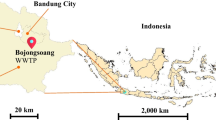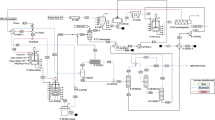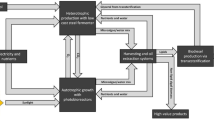Abstract
Microalgae are considered a promising feedstock for the production of sustainable biofuels and biochemicals. Within the EU-funded demonstration project ‘Industrial scale Demonstration of Sustainable Algae Culture for Biofuels Production’ All-Gas (FP7-268208), a comprehensive life cycle assessment (LCA) was carried out. The project aims at demonstrating the feasibility of the sustainable production of biomethane based on low-cost microalgae cultures grown in municipal waste water. The full chain of processes from open algae ponds, downstream processing for biomethane production as well as the demonstration of use in vehicles is being implemented on a 10-ha facility in Chiclana de la Frontera (Spain). In contrast to many other LCA studies on algal biofuels, this LCA study used real pilot-scale data. However, it became clear that there still remains the challenge to acquire data with a high quality in particular for algae cultivation which requires a consistent data acquisition over several years. The results of the LCA show that compared to conventional waste water treatment and to the use of biomethane instead of compressed natural gas as vehicle fuel, the investigated algae biorefinery offers clear benefits with regard to the protection of the climate, protection of fossil resources and ozone depletion. In other impact categories such as particulate matter formation, photochemical oxidant formation, water deprivation or eutrophication, the performance of the investigated algae biorefinery is worse. Although there are still technical and environmental drawbacks associated with the algae biorefinery under investigation, the positive aspects already present at this time make it seem worthwhile to further develop and to further optimise this technological approach.





Similar content being viewed by others
References
European Parliament (2015) European parliament legislative resolution of 28 April 2015 on the Council position at first reading with a view to the adoption of a directive of the European Parliament and of the Council amending Directive 98/70/EC relating to the quality of petrol and diesel fuels and amending Directive 2009/28/EC on the promotion of the use of energy from renewable sources (10710/2/2014 – C8-0004/2015–2012/0288(COD))
Darzins A, Pienkos P, Edye L (2010) Current status and potential for algal biofuels production, a report to IEA bioenegy task 39, Golden
Murthy GS (2011) Overview and assessment of algal biofuels production technologies. In: Pandey A, Larroche C, Ricke SC et al (eds) Biofuels: alternative feedstocks and conversion processes, 1st edn. Academic Press, Amsterdam, Boston, Heidelberg, London, New York, Oxford, Paris
Grierson S, Strezov V, Bengtsson J (2013) Life cycle assessment of a microalgae biomass cultivation, bio-oil extraction and pyrolysis processing regime. Algal Res 2(3):299–311. doi:10.1016/j.algal.2013.04.004
Batan L, Quinn J, Willson B et al (2010) Net energy and greenhouse gas emission evaluation of biodiesel derived from microalgae. Environ Sci Technol 44(20):7975–7980. doi:10.1021/es102052y
Campbell PK, Beer T, Batten D (2010) Life cycle assessment of biodiesel production from microalgae in ponds. Bioresour Technol 102(1):50–56. doi:10.1016/j.biortech.2010.06.048
Lardon L, Hélias A, Sialve B et al (2009) Life-cycle assessment of biodiesel production from microalgae. Environ Sci Technol 43(17):6475–6481. doi:10.1021/es900705j
Sander K, Murthy G (2010) Life cycle analysis of algae biodiesel. Int J LCA 15(7):704–714. doi:10.1007/s11367-010-0194-1
Stephenson AL, Kazamia E, Dennis JS et al (2010) Life-cycle assessment of potential algal biodiesel production in the United Kingdom: a comparison of raceways and air-lift tubular bioreactors. Energy Fuel 24(7):4062–4077. doi:10.1021/ef1003123
Passell H, Dhaliwal H, Reno M et al (2013) Algae biodiesel life cycle assessment using current commercial data. J Environ Manage 129:103–111. doi:10.1016/j.jenvman.2013.06.055
Beal CM, Hebner RE, Webber ME et al (2012) The energy return on investment for algal biocrude: results for a research production facility. Bioenerg Res 5(2):341–362. doi:10.1007/s12155-011-9128-4
Zhou W, Chen P, Min M et al (2014) Environment-enhancing algal biofuel production using wastewaters. Renew Sust Energ Rev 36:256–269. doi:10.1016/j.rser.2014.04.073
Maga D (2015) A methodology to assess the contribution of biorefineries to a sustainable bio-based economy. Karl Maria Laufen, Oberhausen; Dissertation also available online at: http://publica.fraunhofer.de/documents/N-364431.html
Maga D (2015) Life cycle assessment of biomethane from waste water algae: the all-gas approach. In: Unidad de Desarollo Technologico (ed) Abstracts, pp 98–99
Bradley T, Maga D, Antón S (2015) Unified approach to life cycle assessment between three unique algae biofuel facilities. Appl Energy 154:1052–1061. doi:10.1016/j.apenergy.2014.12.087
Thinkstep AG (1992–2015) GaBi software-system and database for the life cycle engineering, Leinfelden-Echterdingen
Kopfmüller J, Brandl V, Jörissen J et al (2001) Nachhaltige entwicklung integrativ betrachtet: konstitutive elemente, regeln, Indikatoren. Edition sigma, Berlin
Goedkoop M, Heijungs R, Huijbregts M et al. (2013) ReCiPe 2008: a life cycle impact assessment method which comprises harmonised category indicators at the midpoint and the endpoint level. First edition (revised). Report I: Characterisation, Amersfoort, Leiden, Nijmegen, Bilthoven
Mulder K, Hagens NJ (2008) Energy return on investment: toward a consistent framework. AMBIO: J Human Environ 37(2):74–79. doi:10.1579/0044-7447(2008)37[74:EROITA]2.0.CO;2
Guinée JB, Gorrée M, Heijungs R et al (2002) Handbook on life cycle assessment: operational guide to the ISO standards. Centre of Environmental Science – Leiden University, New York
Pfister S, Koehler A, Hellweg S (2009) Assessing the environmental impacts of freshwater consumption in LCA. Environ Sci Technol 43(11):4098–4104. doi:10.1021/es802423e
Myhre G, Shindell D (2013) Anthropogenic and natural radiative forcing: In: T. Stocker, et al. eds. Climate change 2013: the physical science basis. Contribution of working group I to the Fifth assessment report of the intergovernmental panel on climate change
JRC (2010) ILCD handbook: recommendations for life cycle impact assessment in the European context, Ispra
Tillman A (2000) Significance of decision-making for LCA methodology. Environ Impact Assess Rev 20(1):113–123. doi:10.1016/S0195-9255(99)00035-9
Doka G (2009) Life cycle inventories of waste treatment services part IV: wastewater treatment: ecoinvent data v2.1. ecoinvent report No. 13 - IV, Dübendorf, Switzerland
ISO (2012) Environmental management—life cycle assessment—illustrative examples on how to apply ISO 14044 to goal and scope definition and inventory analysis (14049)
Ecoinvent Centre (2014). Swiss centre for life cycle inventories, Dübendorf
U.S. Department of Energy (2013) GREET model: the greenhouse gases, regulated emissions, and energy use in transportation model. Argonne National Laboratory
Sheehan J, Dunahay T, Benemann J et al. (1998) A look back at the U.S. Department of Energy’s Aquatic Species Program—biodiesel from Algae, Golden, Colorado
Cuhls C, Mähl B, Clemens J (2014) Ermittlung der Emissionssituation bei der Verwertung von Bioabfällen. gewitra Ingenieurgesellschaft für Wissenstransfer mbH, Troisdorf
Acknowledgments
The author acknowledges the European Commission for supporting the project All-Gas - ‘Industrial scale Demonstration of Sustainable Algae Culture for Biofuels Production’ (FP7-268208) under the 7th Framework Programme. The author would also like to thank the project partners of the All-Gas project who have collected the necessary data for the life cycle assessment.
Author information
Authors and Affiliations
Corresponding author
Electronic supplementary material
Below is the link to the electronic supplementary material.
ESM 1
(TXT 31 kb)
Rights and permissions
About this article
Cite this article
Maga, D. Life cycle assessment of biomethane produced from microalgae grown in municipal waste water. Biomass Conv. Bioref. 7, 1–10 (2017). https://doi.org/10.1007/s13399-016-0208-8
Received:
Revised:
Accepted:
Published:
Issue Date:
DOI: https://doi.org/10.1007/s13399-016-0208-8




